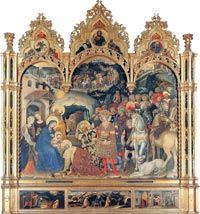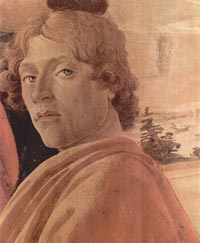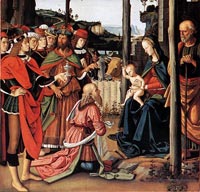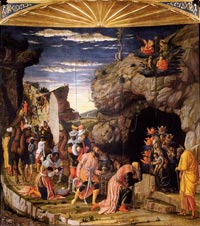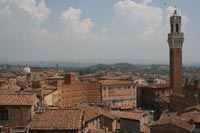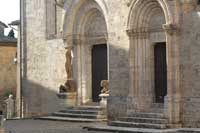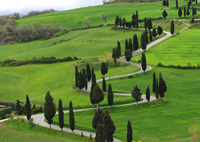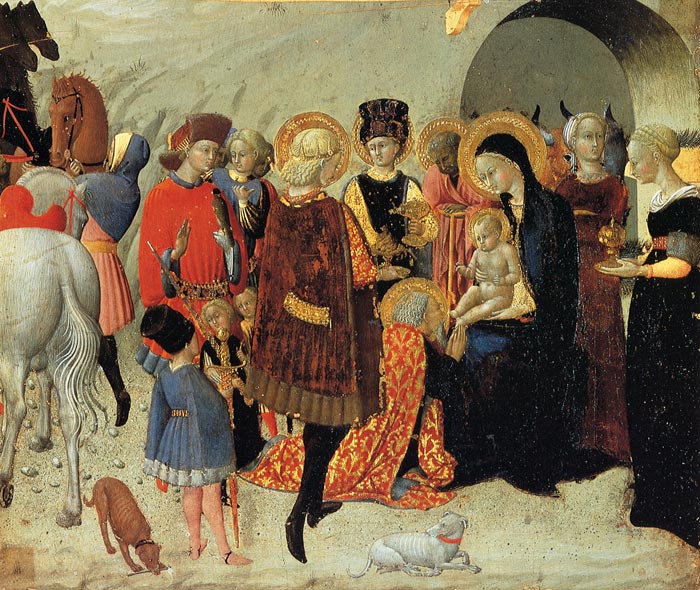 |
Sassetta, Adoration of the Magi; about 1435, Siena, Chigi-Saracini Collection (Monte dei Paschi)
|
| The Adoration of the Magi |
The Adoration of the Magii is the name traditionally given to the Christian subject in the Nativity of Jesus in art in which the three Magi, represented as kings, especially in the West, having found Jesus by following a star, lay before him gifts of gold, frankincense, and myrrh, and worship him. In the church calendar, this event is commemorated in Western Christianity as the Feast of the Epiphany (January 6). The Orthodox Church commemorates the Adoration of the Magi on the Feast of the Nativity (December 25). Christian iconography has considerably expanded the bare account of the Biblical Magi given in the second chapter of the Gospel of Matthew (2:1-11) and used it to press the point that Jesus was recognized, from his earliest infancy, as king of the earth. Many hundreds of artists have treated the subject. A very partial list of the most celebrated is: * Bosch: Museo del Prado, Madrid Fra Angelico and Filippo Lippi, 15th century * Fra Angelico: Museo S. Marco, Florence |
Leonardo da Vinci (Italian, 1452-1519). Study for the Adoration of the Magi (ca. 1481). Pen, watercolored-brown ink and white lead with metal point traces on light brown paper. 16.2 x 29 cm (6.4 x 11.4 in.). Gabinetto dei Disegni e delle Stampe degli Uffizi. © Soprintendenza Speciale Polo Museale Fiorentino. Photograph provided by the Library of Congress, Washington, D.C.
|
||
| Pietro Lorenzetti |
||
| The three wise men have arrived. Find the star that guided them. The horses in the background are there to show they have made a long journey from the East. They are giving the Infant gifts of gold, frankincense, and myrrh, which mean that Jesus is at once a king, a god, and a man. Note that the halos are either round or hexagonal. They indicate the holiness of the figures. |
Pietro LORENZETTI - Adoration of the Magi c. 1340 Wood, 33 x 24 cm Musée du Louvre, Paris © Musée du Louvre |
|
| Bartolo di Fredi |
||
| This altarpiece was commissioned for the cathedral of Siena.
Bartolo di Fredi was one of the most popular masters in Siena in the second half of the fourteenth century. He maintained a large workshop. He was influenced by both Simone Martini and Pietro Lorenzetti, and following late Gothic inspirations he developed his style on this basis. The Adoration of the Magi is characterized by a lively dynamism like in Lorenzetti's paintings. The only tranquil detail is Mary sitting with the Child on the right side. The three kings arrive with a big accompaniment from the left. The big striped hats in the hands of the members of the accompaniment is well known from the St Martin fresco cycle of Simone Martini in Assisi. The background scene is a reference to the long journey of the kings between cities and mountains. The walled city is Siena with the black and white striped Cathedral and the bell-tower. No organic connection can be observed between the foreground and background. |
The Adoration of the Magi 1385-88 Tempera on panel, 195 x 163 cm Pinacoteca Nazionale, Siena |
|
The motif of the Adoration of the Magi was unusual for Florentine altar scenes until the 15th century. One of the first presentations of the Adoration of the magi is found on the Strozzi altar of Gentile da Fabiano, dating in 1423. But the 15th century was its golden age, probably due to many brotherhoods in Florence. One of the most important congregations was so-called Brotherhood of the Magi, (Compania dei Magi, also called Confraternity of the Star). Their selected members also included the Medici family. Compagnia dei Magi organized magnificent processions in Florence, from the monastery of St Marco to the Baptistery, which were performed every five years on Epiphany, the feast day of the Magi. Lorenzo il Magnifico, the grand son of Cosimo il Vecchio was even baptized on January the 6th, the feast day of the Magi. |
||
| Gentile da Fabriano, c. 1370 - 1427 |
||
|
Gentile da Fabriano (1370-1427) was an Italian painter known for his participation in the International Gothic style at the beginning of the 15th century. The few surviving works are among the finest examples of the International Gothic style. Gentile was born in or near Fabriano, in the Marche. By the 1420s he was working in Florence, where he painted his famous altarpiece depicting the Adoration of the Magi (1423), now in the Uffizi and regarded as one of the masterpieces of the International Gothic style. The Adoration of the Magi, housed in the Uffizi Gallery in Florence, Italy, is considered his finest work, and has been described as "the culminating work of International Gothic painting". Commissioned by Palla Strozzi, this brilliant narrative spectacle is rich with sentiment, psychological observation, and an unusually detailed description of nature.
|
||
| Massaccio |
||
| Massaccio’s Adoration of the Magi included in a polyptych in Pisa and dating in 1426 is a total contrast to Gentile’s narrative and ornamental perception of the space. Masacci’s space is denoted by standard usage of the perspective which, by using the central vanishing point, enables him to realistically arrange the figures and the landscapes. Even Alberti thanked him for using the “old motif” in a completely new way in the appendix to the Italian version of his most famous work Della Pitura:
I believed ... that Nature, mistress of things, had grown old and weary, and was no longer producing intellects any more than giants on a vast and wonderful scale... But after I came back here to this most beautiful of cities from the long exile in which we Albertis have grown old, I recognized in many, but above all in you Filippo Brunelleschi, and in our great friend the sculptor Donatello, and in others, Nencio Ghiberti?, Luca della Robia and Masaccio, a talent ingegno for every laudable enterprise in no way inferior to any of the ancients who gained frame in these arts. [3. Leon Batista Alberti, On Painting.] This painting is the central predella panel of the Pisa Altarpiece, directly beneath the enthroned Madonna and Child. Compared to Gentile da Fabriano's painting of the same subject done in Florence just a few years before, Masaccio's treatment is entirely new. Besides offering lifelike portraits of the patron and his nephew in contemporary dress at the middle right, he has given the entire scene a convincing atmosphere which surrounds the figures and the landscape. In the distance, the atmosphere breaks down the clarity of the forms resulting in an effect which is referred to as aerial perspective. Although there are some composition similarities with Gentile’s Adoration of the Magi (the holy family portrayed from the profile on the right side, adoration of the magi in the middle and the suite with horses on the left side), Masaccio did concentrate on the basic motif. The painting ceases to be a mare illustration of the text (in this case the biblical story), but an independent composition within a Renaissance comprehension of the space. The progressive, if by no means uniformly accepted, disentanglement of the figural from its textual task – the denarrativization of the ocular we might call it – was an important element in this larger shift from reading the world as an intelligible text (the "book of nature") to looking at it as an observable but meaningless object, which Foucault and others have argued was the emblem of the modern epistemological order. Only with this epochal transformation could the "mechanization of the world picture" so essential to modern science to take place. The painting also presents the full-figured portraits of the commissioner Giuliano di Ser Colino and his son. They are painted in perspective and incorporated in the scene, but at the same time, mostly because they are placed in the front and have very realistic faces and clothes, they appear as if observing the scene from the outside and still look like the medieval (mostly northern) votive portraits of the commissioners at the side edges of the paintings. We will be able to observe the incorporation of the portrait into the biblical space in later presentations of this motif (Botticelli). In the mass of bodies in the upper right side of the painting, we notice a face of a servant looking at us and it is probably one of those figures which attracts the viewer’s attention and draws him into the painting as we will see later on. |
||
Fra Filippo Lippi and Fra Angelico |
||
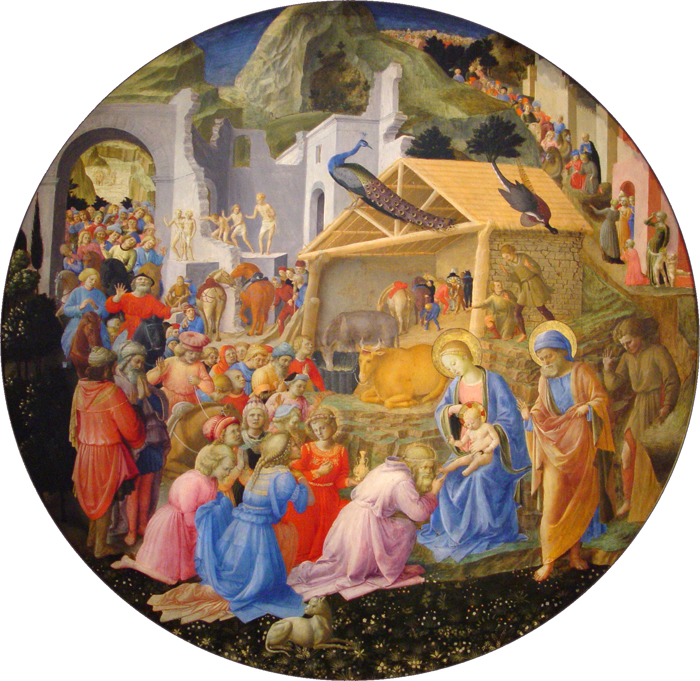 |
||
Fra Filippo Lippi and Fra Angelico, Adoration of the Magi (detail), c. 1445, tempera on wood, National Gallery of Art, Washington
|
||
| This tondo has long been the subject of scholarly debate over its authorship which has oscillated between Fra Filippo Lippi and Fra Angelico. It was painted for Cosimo de' Medici, or at least we know it was in the Medici Palace according to an inventory taken in 1492 where it was listed as by Fra Angelico. Following the three kings a splendid procession, symbolizing all the races of mankind, waits to pay homage to the new-born Christ. The peacock is a symbol of the Resurrection. Some scholars believe that Fra Angelico laid out the composition and painted the Virgin and Child and at least some of the figures at the upper right; then his associate and fellow monk Fra Filippo Lippi completed the work. This brilliantly colored, richly decorated circular panel presents a splendid vision of the arrival of the Magi, accompanied by a courtly entourage. A 1492 inventory of Lorenzo de' Medici's estate possibly identifies this picture as the most valuable in the collection of the powerful Florentine family, and attributes it to Fra Angelico. The Adoration of the Magi actually appears to be the product of two artists; Fra Angelico may only have started the altarpiece, the greatest part of the work having been taken up by Fra Filippo Lippi. Fra Angelico was a Dominican known for his great monastic devotion; his saintly deportment is mirrored in the quiet piety of his paintings. The representation of the Virgin Mary here characterizes his style in the pure, simple form of her head and the gentle refinement of her features. Fra Filippo's earthy style appeals to the viewer in the portrayal of massive forms and well-articulated figures. In the Adoration, the richly attired wise men and their attendants, as well as the broad-faced Joseph beside the Virgin, are usually attributed to him. While several elements of the painting can be seen as symbolic – for example, the peacock was considered a symbol of immortality – the Adoration can also simply be appreciated for its sparkling color, delightful details, and festive gaiety.[2] |
||
| Sandro Botticelli |
||
 |
||
Sandro Botticelli, Adoration of the Magi, c. 1475-1476, tempera on panel, Uffizi, Florence |
||
Somewhere around 1475, Sandro Botticelli painted the famous Adoration of the Magi for Guasparre di Zanobi del Lama, a work in which the artist also depicted himself. This painting established Botticelli's fame in Florence, and may rightfully be considered the high point of his early artistic output.
|
||
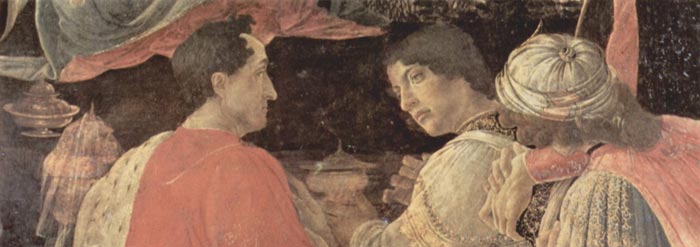 |
||
Sandro Botticelli, 1446 - 1510, The Adoration of the Magi (detail), c. 1475, tempera on panel, Galleria degli Uffizi, Florence |
||
This picture was commissioned by Guasparre del Lama, a social upstart. He had Botticelli paint portraits of members of the Medici family as the Magi and some of their entourage in order to give expression to his attachment to this powerful family. Del Lama may be seen among the crowd of people on the right-hand side of the picture, am elderly man with white hair and a light blue robe looking at the observer and pointing in the latter's direction with his right hand. Among the company of worshippers at far right, we recognize Botticelli, who has depicted himself gazing at the observer, as was customary in self-portraits at that time. |
||
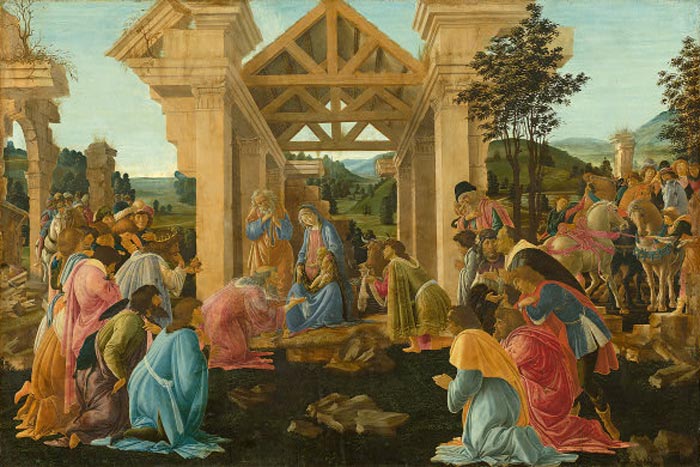 |
||
Sandro Botticelli, 1446 - 1510, The Adoration of the Magi, c. 1478/1482, tempera and oil on panel, National Gallery of Art, Washington |
||
| Botticelli probably executed this painting while still in Rome. An intimation that the picture was perhaps done during Botticelli's stay in Rome can be seen in the groom in the background on the right who is attempting to bring his horse under control; Botticelli probably adapted this motif from the classical sculptures of the Dioscuri, the horse-tamers, in Rome. In contrast to Botticelli's earlier versions of the Adoration, the Virgin and the Christ Child now form the painting's main focal point, uncontested by any of the figures accompanying them. As in the Adoration done for Guasparre del Lama, those present here are arrayed around the Virgin in a semicircle; in this picture, however, Botticelli has opened up the semicircle towards the observer, so that the latter's gaze may reach the Virgin unhindered. At the same time, all those involved, their postures and gestures, are directed towards the Mother of God, lending the painting a dramatic unity which the earlier Adorations lacked. The artist's recording of the figures' various reactions demonstrates once again the importance for Botticelli of Alberti's treatise on painting. The art theoretician recommended for the edification of the observer not only the greatest variation in the possible palette of emotions but also the depiction of people of differing age, together with alternation in the perspectives offered by the figures, who should be presented from various sides in three-quarter and half profile or from the front. Botticelli's wealth of variation in the fashioning of his figures fulfilled all of these demands, yet without losing the central focus of the picture's content. For most of the fifteenth century, the Epiphany was celebrated in Florence with a great festival. Expensively clad citizens reenacted the journey of the three kings to Bethlehem with processions through the streets. Shortly before this work was painted, however, the elaborate pageantry of the festival was curtailed. Preachers like Savonarola complained that excessive luxury obscured the day's religious significance. Botticelli's painting seems to reflect this new concern. He places Jesus at the center of a powerful X formed by the opposing triangles of kneeling worshipers and the roof of the manger. The viewer, rather than being overwhelmed by rich detail, is instead aware of the quiet distance between him and the holy figures—and like the worshipers in the painting leans toward the infant. This yearning to close the gap between human existence and the divine was a frequent Neoplatonic theme. Botticelli may have painted this while in Rome working on the Sistine Chapel. Rearing horses in the background, for example, appear to reflect the colossal horses of the Dioscuri. The classical architecture of the manger and the crumbling ruins also have theological significance. Legend held that earthquakes destroyed pagan temples at the moment Christ was born, and in a more general sense ruins suggest that the old order of the Law of Moses is supplanted by the new era of Grace made possible by Christ's birth.[2] |
||
Benozzo Gozzoli, Procession of the Magi, 1459-60 |
||
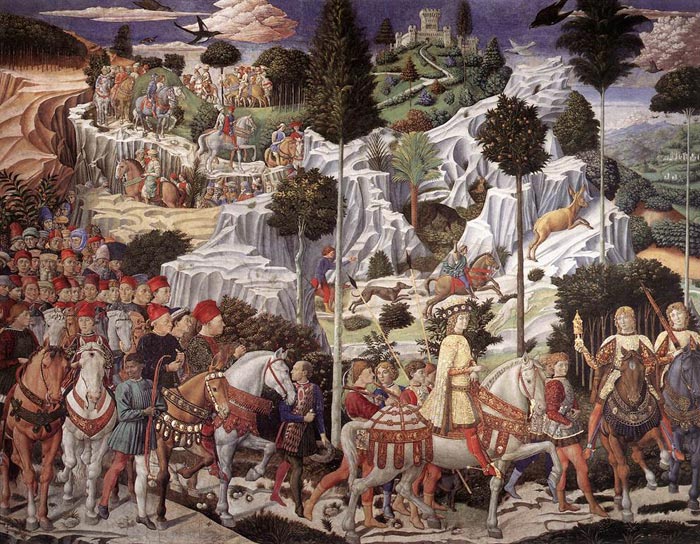 |
||
Benozzo Gozzoli, Procession of the Magi, 1459-60, Palazzo Medici-Riccardi, Firenze |
||
| The Chapel of the Magi occupies an important place in the Medici Palace which Cosimo the Elder built, starting in about 1444, in accordance to the architectural design by Michelozzo di Bartolomeo. The Chapel is famous for the series of wall paintings by Benozzo Gozzoli, with the Angels in Adoration in the rectangular apse and the Journey of the Magi in the large hall. The Procession of the Magi occupies three walls of the main room and is accompanied by frescoes portraying the Shepherds awaiting the announcement above the doors of the small vestries. Painted during the years subsequent to 1459, but in any case by 1463, they represent the masterpiece oft his painter, dedicated to a sacred subject but rich in traces of pomp and seculare legance with all the care that Cosimo and Piero de' Medici - as exigent buyers and connoisseurs of art - expected of him. Hosts of angels sing and adore on a rural background civilly partioned, like the typical Florentine countryside. While the magnificent procession of the Three Kings approaches Bethelem accompanied by their respective entourages they enjoy the scene of a noble hunting party with falcone and felines along the way. The sumptuous and varied costumes with their princely finishings make this pictorial series one of the most fascinating testimonies of art and costume of all time. Among the followers of the Magi there are numerous family portraits. On the north wall, in the entourage of young King Kaspar (whom poetic tradition considers an ideal portrait of Lorenzo de' Medici, the future "Magnifico"), may identified Cosimo with his sons Piero, Giovanni and Carlo, the young princes Lorenzo and Giuliano di Piero and the painter Benozzo.[1] The restoration of the paintings (1987-1992) have revealed a refined and complex operational technique and made it possible to fully appreciate Benozzo's compositional capacity. He was a skilled constructor of animated landscape backdrops in perspective, besides being an analytical witness of the knightly pomp of the Court, in which are incorporated the memories of magnificent parades which, during the Feast of Magi the and on other important celebrative occasions, wended their way along the Via Larga under the palace windows. [read more] |
||
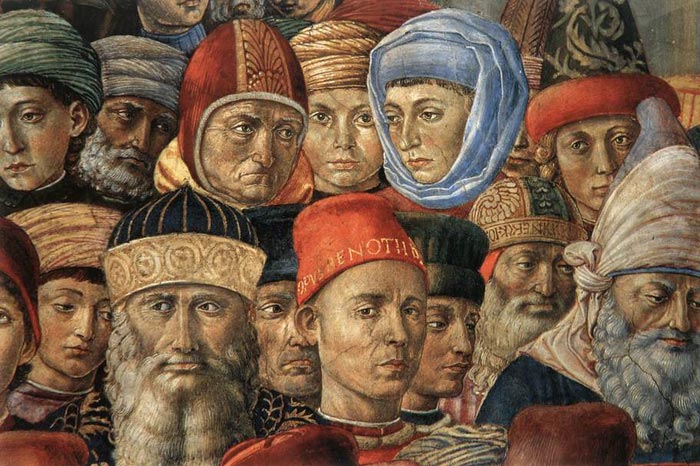 |
||
Benozzo Gozzoli, Procession of the Magi (detail), 1459-60, Palazzo Medici-Riccardi, Firenze |
||
| Most of the figures in the Procession of the Magi were painted from live models and given the likeness of Benozzo Gozzoli's contemporaries. The painter tried to represent as many likeness as possible, often without concern for the actual space taken up by the body. Only a few figures enjoy sufficient space. The artist's self-portrait is indicated by an inscription BENOTII on his hat. | ||
| Pietro Perugino |
||
Pietro Perugino (1446–1524), born Pietro Vannucci, was the leading painter of the Umbrian school, who developed some of the qualities that found classic expression in the High Renaissance. Pietro Vanucci was born in Città della Pieve and was called Perugino after the town of Perugia, where he worked. As a professional painter and the overseer of two or more workshops consecutively, Perugino had great and international success. Raphael was his most famous pupil. |
||
| Andrea Mantegna (1430/31 - 1506) |
||
| Andrea Mantegna was an outstanding northern Italian painter, engraver and occasional sculptor. By influence of his friend Alberti he also worked as an achitect. Andrea Mantegna, one of the chief heroes in the advance of painting in Italy, was born in Vicenza, of very humble parentage. It is said that in his earliest boyhood Andrea was, like Giotto, put to shepherding or cattle-herding; this is not likely, and can at any rate have lasted only a very short while, as his natural genius for art developed with singular precocity, and excited the attention of Francesco Squarcione, who entered him in the guild of painters before he had completed his eleventh year. Squarcione, whose original vocation was tailoring, appears to have had a remarkable enthusiasm for ancient art, and a proportionate faculty for acting, with profit to himself and others, as a sort of artistic middleman; his own performances as a painter were merely mediocre. As the youth progressed in his studies, he came under the influence of Jacopo Bellini, a painter considerably superior to Squarcione, father of the celebrated painters Giovanni and Gentile, and of a daughter Nicolosia; and in 1454 Jacopo gave Nicolosia to Andrea in marriage. From 1460 until his death he worked as the official court painter to the Gonzaga of Mantua. Mantegna's first important commission from Ludovico Gonzaga was the decoration of the chapel in Castello di San Giorgio, executed in the first half of the 1460s. It is unfortunately impossible to reconstruct the whole of Mantegna's original intentions there with any confidence, although some panels almost certainly traceable to the chapel still survive. Successful and admired though he was in Padua, Mantegna left his native city at an early age, and never afterwards resettled there; the hostility of Squarcione has been assigned as the cause. The rest of his life was passed in Verona, Mantua and Rome — chiefly Mantua. The influence of Mantegna on the style and tendency of his age was very marked, and extended not only to his own flourishing Mantuan school, but over Italian art generally. His vigorous perspectives and trenchant foreshortenings pioneered the way to other artists; in solid antique taste, and the power of reviving the aspect of a remote age with some approach to system and consistency, he distanced all contemporary competition. |
||
Together with The Ascension and The Circumcision, the Adoration of the Magi forms a triptych created in 1827 at the Uffizi, where the picture can still be seen. The three works were acquired by the Medici in 1588 by the Gonzaga, whose member Ludovico had commissioned them to Mantegna in the 1460s for the Chapel of the Castle of St. George in Mantua (together with the Death of the Virgin, now in the Museo del Prado).
The panel with the Adoration of the Magi was probably located in the chapel's apse. The Magi are depicted while descending to the Child's grotto from a path carved out in the rock. The Virgin is portrayed with a crown of angels, according to a Byzantine model. The Getty Museum's magnificent painting by Mantegna, The Adoration of the Magi, is based on one of Christianity's most beloved stories: the arrival of the gift-bearing Wise Men at the newborn Jesus' crib in a manger in Bethlehem. The picture is much more than a Christmas-card image, however. Influenced by the presence of classical Roman relief sculpture in his native Padua, Mantegna depicts the Christ Child blessing the three kings in the presence of his simply attired mother, the Virgin Mary, and Joseph, her husband. The Wise Men, portrayed against a neutral background, are exotically clothed. The bearded, bareheaded and reverential Caspar gives Jesus a Chinese porcelain cup full of gold coins. Next to him stands the youthful Melchior with a Turkish jasper censer rich in aromatic frankincense. The covered agate vessel held by Balthasar contains myrrh, an East African and Arabian tree resin used in ancient perfumes and ointments. |
||
Three kings pay homage to the Christ Child, who in turn makes a sign of blessing. Jesus Christ, his mother the Virgin Mary, and Mary's husband Joseph have haloes and wear simple garments, while the Magi are dressed in exotic clothing and jewels and bear exquisite gifts. Caspar, bearded and bareheaded, presents the Christ Child with a rare Chinese cup, made of delicate porcelain and filled with gold coins. Melchior, the younger, bearded king behind Caspar, holds a Turkish censer for perfuming the air with incense; on the right, Balthasar the Moor carries a covered cup made of agate. |
||
Domenico Ghirlandaio | The Adoration of the Magi
|
||
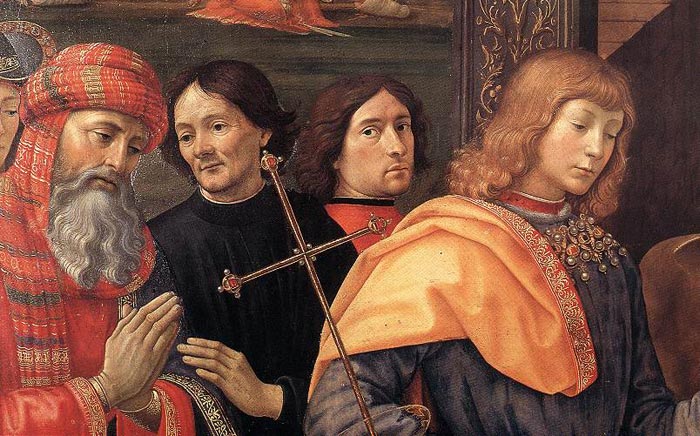 |
||
Domenico Ghirlandaio, Adoration of the Magi (detail, self Portrait), 1488, Spedale degli Innocenti, Firenze |
||
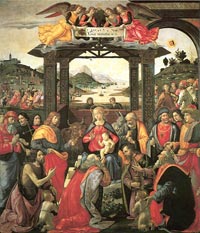 |
||
|
|||||||||||||||||||||||||||||||||||
|
|||||||||||||||||||||||||||||||||||
|
|
|||||||||||||||||||||||||||||||||||
|
|||||||||||||||||||||||||||||||||||

